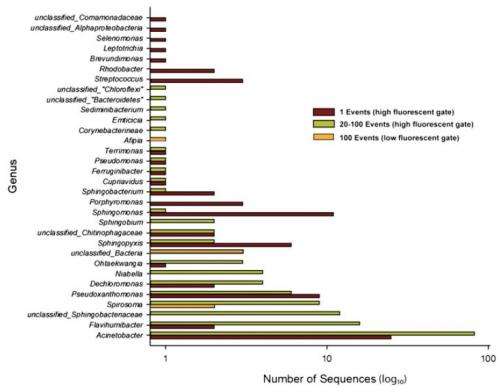June 11, 2013 report
Researchers sequence genome of mysterious candidate phylum TM6 bacteria

(Phys.org) —Researchers at the J. Craig Venter Institute have succeeded in sequencing the genome of a mysterious type of bacteria known only by its status—candidate phylum TM6. The sample sequenced, the team reports in their paper published in Proceedings of the National Academy of Sciences, was found in a sink drain in a hospital.
Scientists know that there are a lot of bacteria in the world that have yet to be discovered. Sometimes all they show are evidence of where they've been, leading some to call them the "dark matter" of life. One of these, currently dubbed candidate phylum TM6 (first discovered in 1996) is suspecting of living in treated water systems all around the world—since they can't be grown in a lab, scientists don't know if they are harmful, helpful or neither. They tend to leave behind evidence of their existence in drains and showerheads, so that's where the researchers looked after setting up a means of examining them.
They found their sample in the form of a biofilm in a sink drain in a public restroom in a hospital. It was of course one of many bacteria in the sample which meant it had to be separated from the others first using fluorescent tagging. The resulting clean sample held single cells clinging together which the researchers pulled apart allowing them to extract individual DNA. The DNA from the bacteria was then compared with DNA from other known bacteria—that helped to rule out the possibility that it was something else, and also in sequencing its genome.
After much effort, the team was able to piece together roughly 90 percent of the bacteria's genome. In so doing they found that the bacteria is not capable of making its own amino acids, which means it likely needs a host to survive. The team theorizes that the bacteria likely live on an amoeba of some sort, or possibly even another kind of bacteria. They still don't know if TM6 cause problems for us humans however, but suggest the possibility exists—they might be harmful in ways that have not yet been discovered, as other bacteria that use an amoeba as a host have been found to be harmful.
The researchers are hopeful that now that the genome of candidate phylum TM6 has been sequenced, the chances of culturing samples in a lab are much greater. That development would of course lead to a much better understanding of the bacteria and hopefully to learning whether it's something we should be worried about or not.
More information: Candidate phylum TM6 genome recovered from a hospital sink biofilm provides genomic insights into this uncultivated phylum, PNAS, Published online before print June 10, 2013, doi: 10.1073/pnas.1219809110
Abstract
The "dark matter of life" describes microbes and even entire divisions of bacterial phyla that have evaded cultivation and have yet to be sequenced. We present a genome from the globally distributed but elusive candidate phylum TM6 and uncover its metabolic potential. TM6 was detected in a biofilm from a sink drain within a hospital restroom by analyzing cells using a highly automated single-cell genomics platform. We developed an approach for increasing throughput and effectively improving the likelihood of sampling rare events based on forming small random pools of single-flow–sorted cells, amplifying their DNA by multiple displacement amplification and sequencing all cells in the pool, creating a "mini-metagenome." A recently developed single-cell assembler, SPAdes, in combination with contig binning methods, allowed the reconstruction of genomes from these mini-metagenomes. A total of 1.07 Mb was recovered in seven contigs for this member of TM6 (JCVI TM6SC1), estimated to represent 90% of its genome. High nucleotide identity between a total of three TM6 genome drafts generated from pools that were independently captured, amplified, and assembled provided strong confirmation of a correct genomic sequence. TM6 is likely a Gram-negative organism and possibly a symbiont of an unknown host (nonfree living) in part based on its small genome, low-GC content, and lack of biosynthesis pathways for most amino acids and vitamins. Phylogenomic analysis of conserved single-copy genes confirms that TM6SC1 is a deeply branching phylum.
Journal information: Proceedings of the National Academy of Sciences
© 2013 Phys.org




















